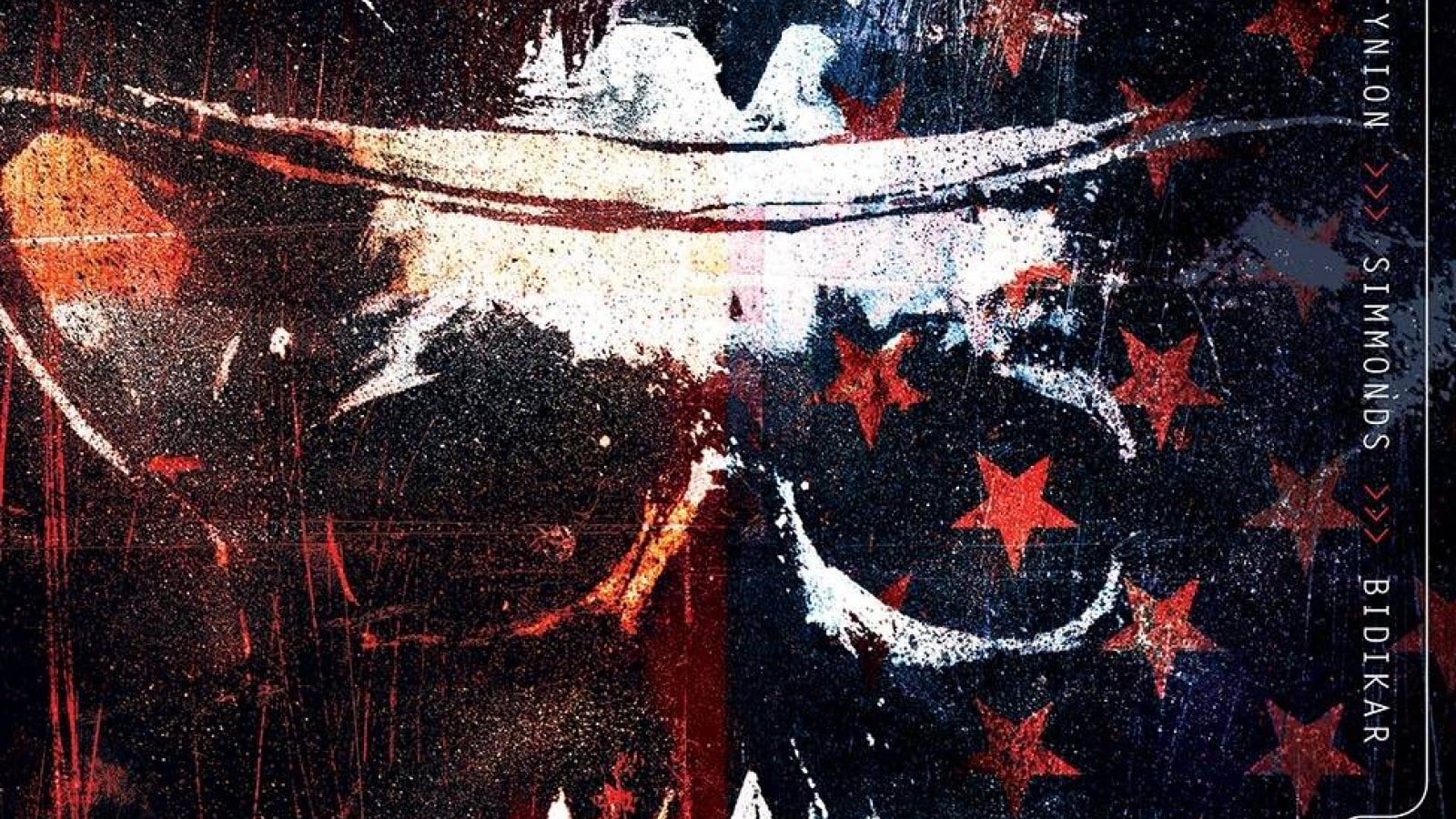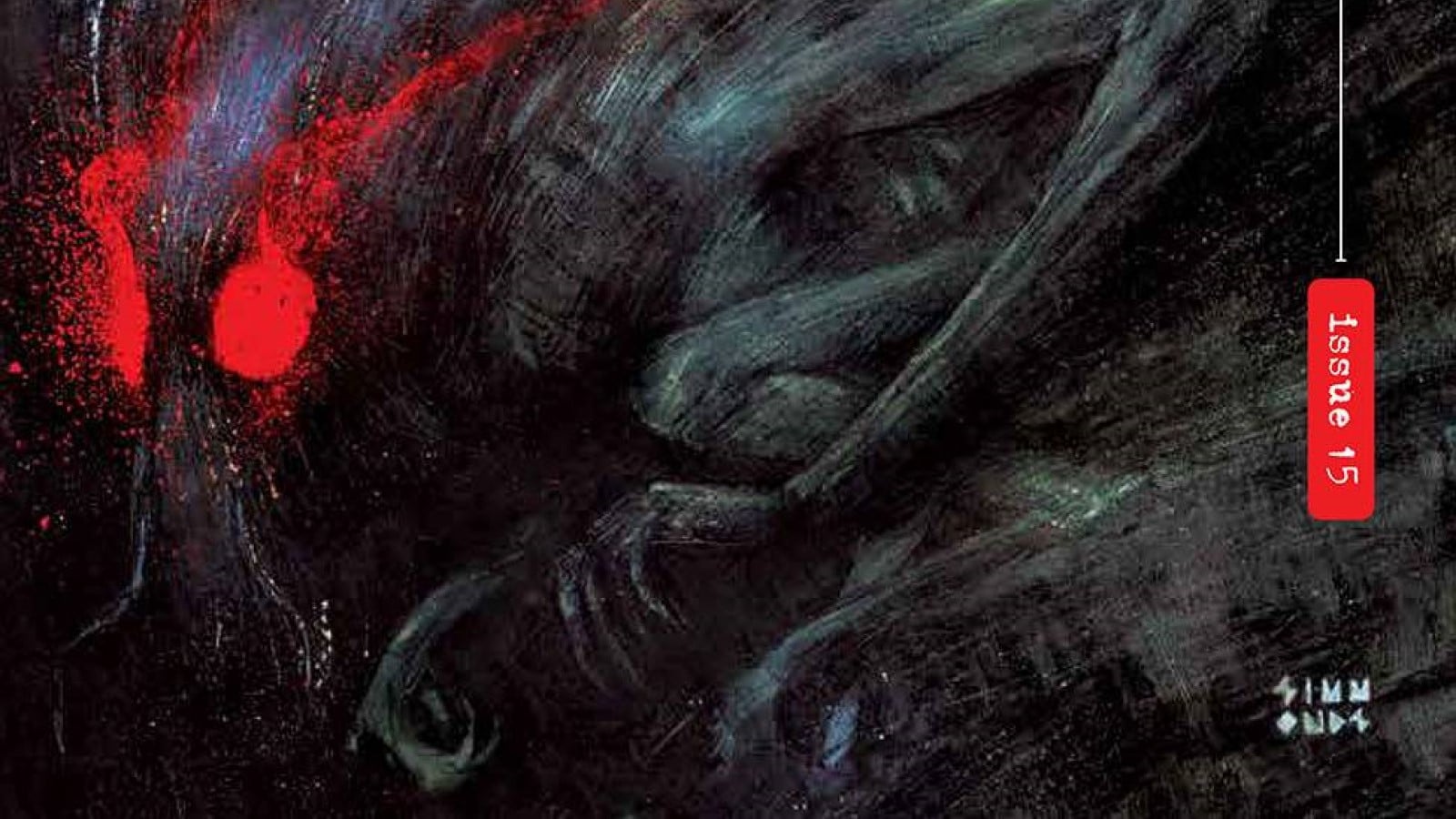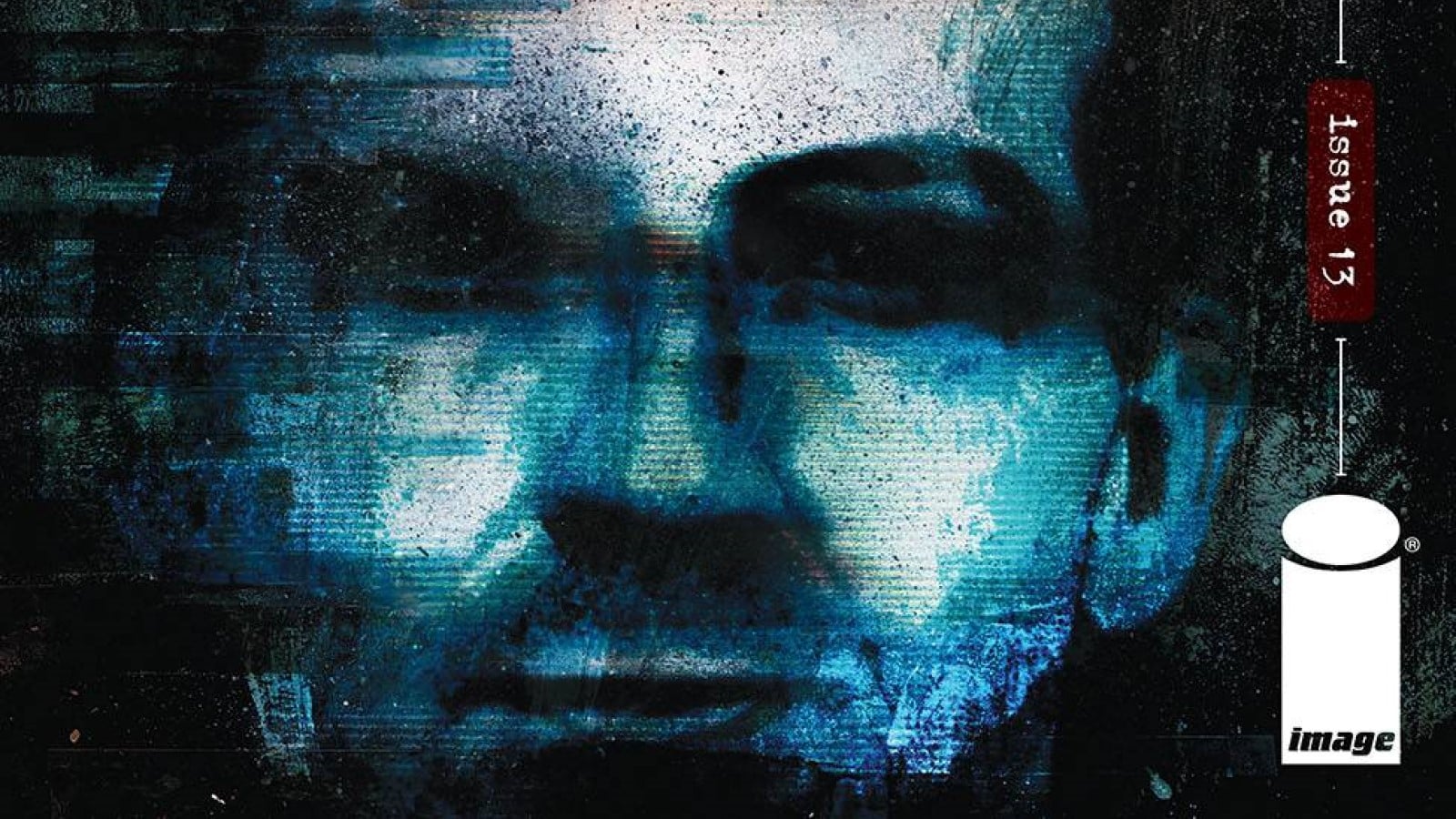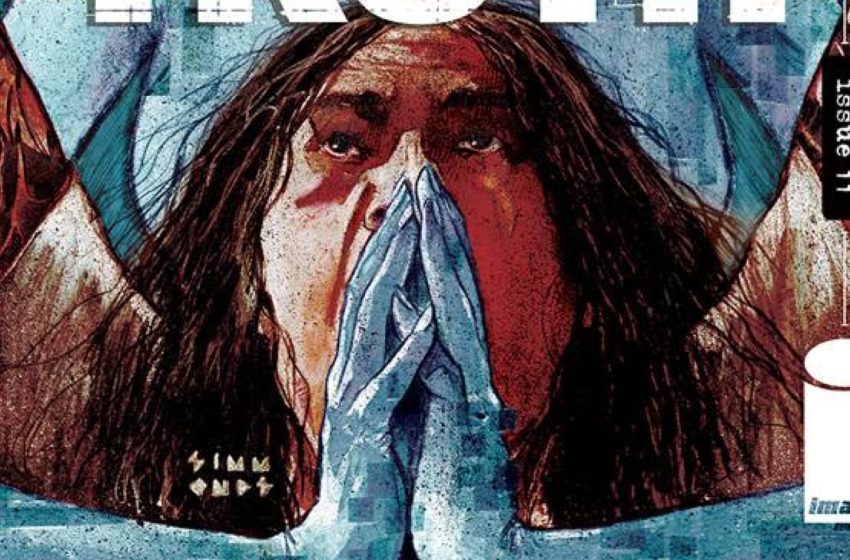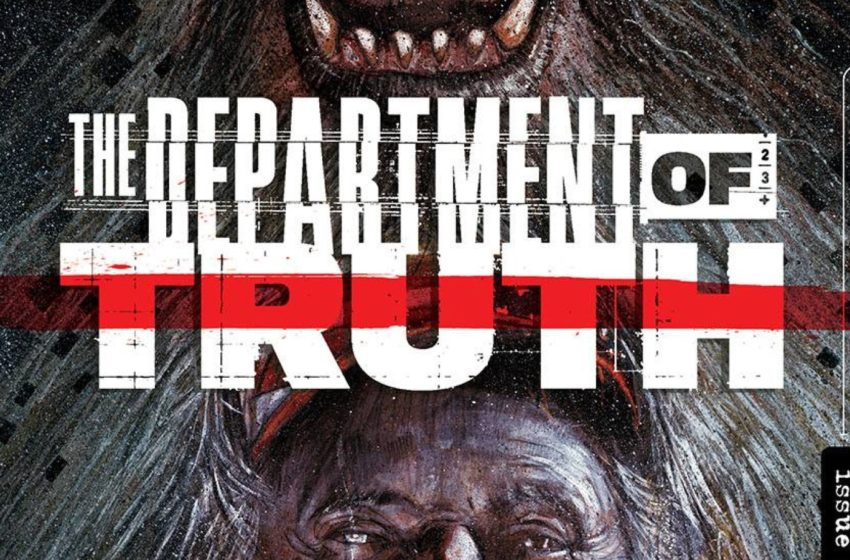Agent Cole Turner is going home, but the world — and the agency he knew — is gone in Department of Truth #12, written by James Tynion IV, illustrated by Martin Simmonds, lettered by Aditya Bidikar, designed by Dylan Todd and edited by Steve Foxe.
Will Nevin: Jumpin’ Jesus alive, we’ve got so much to get to in this chapter of Department of Truth, so let’s waste time by going back to the last one. Forrest, have you ever heard of the Missing 411 conspiracy theory? If you’re not familiar with it, it’s the brainchild of one David Paulides, a Bigfoot hunter who says there are a bunch of spoopy disappearances in and around national parks. (Note: He doesn’t allege there have been 411 missing person cases — it’s a reference to the old directory assistance number. Way to bring in millennials, Dave.) Of course it’s just a blatant fuckin’ back door to Bigfoot shit (“Why do you think the government is hiding all of these disappearances? They’re covering up what really goes on in our national parks — people are gettin’ ate out there!” — Dave, probably), but it got me thinkin’ — if Department of Truth was real and tulpas were real, how would this work? Enough people think Missing 411 is a thing, and then folks disappear, right? But would those be new people manifested into existence, or would people we already have start disappearing into the mist?
These are the things I think about when my house is empty and all I can hear are my cats fighting.
Forrest Hollingsworth: Will, I have seen Missing 411: The Hunted three times. Your question is interesting, because I tend not to think of the 411 as a unified conspiracy theory. It consists of a bunch of disparate details: The disappearances happen around a weather event but also near boulder fields (how are the two related?). Paulides conflates Germanic last names with wearing red. It’s a stunning series of correlations but not causations, and I find myself thinking that the only thing that truly makes them related is Paulides.
Is the work of the Department actually just identifying and neutralizing those unifiers? Are the Black Hats exceptionally good at recruiting them? What if someone believes in the boulder fields but not the weather events? It brings to mind a lot of questions about the minutiae and the moving pieces that the book understandably sweeps under the rug for grander set pieces.
Anyways, now that I’m spiraling, my answer is that there would be existing people who are inclined to believe in the 411 going missing, after one of the core tenets of Department is that everyone wants to be special, even Hawk in his own way.
Will: Sorry for the aside. I thought it was important. Or something. But yes, let’s get to this fresh pile of Truth, and my god, this may be one of my favorite issues so far; we come off of two fairly decompressed stories and then BOOM, everything seems to happen in this story — we get more backstory on Cole and Hawk’s long, long relationship; we learn that Hawk did Ruby Ridge, Waco and Oklahoma City; and — if that shit wasn’t bonkers enough — Hawk (spoiler alert, Loyal Content Consumers) has been a turncoat working with Black Hat.
I mean, goddamn, Forrest.
Forrest: I’m devastated that we’re getting to this column so late (I’m sincerely sorry, readers, my life is falling apart) because you’re right. This is the one that makes a lot of the larger scope “click,” I think. Let’s dig in.
The Visions We Share

Will: Everything about this book is so consistently good; I feel like we can’t talk about all of it the way we should. So before we get into the conspiracy bits, before we try to figure out what this means for our man Cole, how about this: Let’s talk up Simmonds’ work in this issue. From the juxtaposition of adult Cole’s head on his kiddo body and the other surrealness of the flashback to the print-worthy spread featuring Ronald Reagan (*spit*), this issue was stuffed with some of the best art we’ve seen.
Forrest: You’re right on all fronts! I would be interested in doing a page-by-page annotation at some point because a big part of the experience here is the density of the narrative and artistic detail, and how they complement each other, and we haven’t really gotten into depth on that front to date. Anyways, I digress.
I’ve mentioned this before, but I’m especially sensitive to child endangerment, not so much offended by it as I’m put on edge, and that can be masterfully deployed like it is here by Simmonds in the opening sequence.
Cole’s childhood home and mother are so overtly cartoonish, but he and Hawk are rendered more realistically, more darkly. You know the opening scenes of Blue Velvet where the camera pans from the idyllic suburbia to the worms wriggling in the dark, damp dirt below them? It’s evocative of that. There’s an oppressive unease to it, the subtle way Cole is being exposed to intensely upsetting material in the relative safety of his home, the arm reaching out from the television to his pentagram-infused darkened eyes while his mom sits mostly unaware in the other room. Hawk hovering over him the visage of Satan himself. It’s a strong series of contrasting, contradictory images and colors that really works and sets a stunningly sickening tone, the idea of Cole being guided toward his own abuse from such a young age. Hawk kind of alludes to it with Waco and Oklahoma later, too.
After a decade of reviewing comics, it’s really rare that a book’s imagery, its words, its anything sits with me as long as Department’s do.
The Dark Thoughts, They Come

Will: This one issue was so flippin’ full of that good, good conspiracy theory stuff, I don’t know where to start — Tynion squeezes in references to Michelle Remembers, black helicopters, chemtrails and the Ruby Ridge/Waco/Oklahoma City trifecta of militia/anti-government hokum. Of all of those, Waco probably interests me the most as a widely accepted idea that the government somehow killed the Branch Davidians, whereas in actuality they were a suicide cult who welcomed death at the hands of federal agents. What about you, Forrest — which one of these tulpas was your favorite?
Forrest: Honestly? I think this is the branch (Davidian) of conspiracy theories that is less fun. It’s all about religious fundamentalism, racism, political radicalism, etc., in a way that something admittedly silly but nevertheless thought-provoking like Mothman isn’t.
Tynion is good at that, driving the less dire, immediate stuff back to the violence and insidiousness it passively enables. You can sense Hawk’s frustration with that exact point here; he finds stuff like Bigfoot insignificant in the face of children dying (despite his complicity). He’s struggling with the attention economy, with the depth of depravity and callousness that only people in his position might see, and he’s not necessarily wrong to be feeling that way. I think the turn is justified, and I like the way that narrative took a detour literally losing the forest for the trees in the previous duology before getting back to it.
Sorry I sucked the fun out of this segment. I do think Michelle Remembers is a genuinely fascinating and textually relevant piece of cultural detritus that most readers could just get the gist of from the Wikipedia entry.
Will: Two things before you leave this section, Loyal Content Consumers: (1) Michelle Remembers is a stupid, dumb book that’s really important to understanding the Satanic Panic, and (2) the government didn’t kill anyone in Waco. Important things to know.
Danger’s in the Jumpseat

Will: As if all of this wasn’t enough, we also got those aforementioned blockbuster plot developments — Hawk is a Black Hat double agent, and he’s taking Cole back to Milwaukee for … well, it doesn’t seem to be good. We knew this would eventually happen — you don’t set this sort of thing up without giving your protagonist a chance to face the monster who set him on this strange path — but it’s happening faster than I would have expected. What do you think is waiting for Cole when he gets home? A final Black Hat temptation? Or something more immediately dangerous?
Forrest: Cole’s gonna fistfight the literal Devil, Will.
Will: You heard it here first, folks.
An Eye for an Eye, A Truth for a Truth
- “Repressed memories” — the central idea advanced by Michelle Remembers — don’t exist. But the idea they could suggested to an entire generation that children who were abused at the hands of Satanic cults could remember the abuse if given the proper coaching — i.e. if the “memories” were implanted and encouraged.

